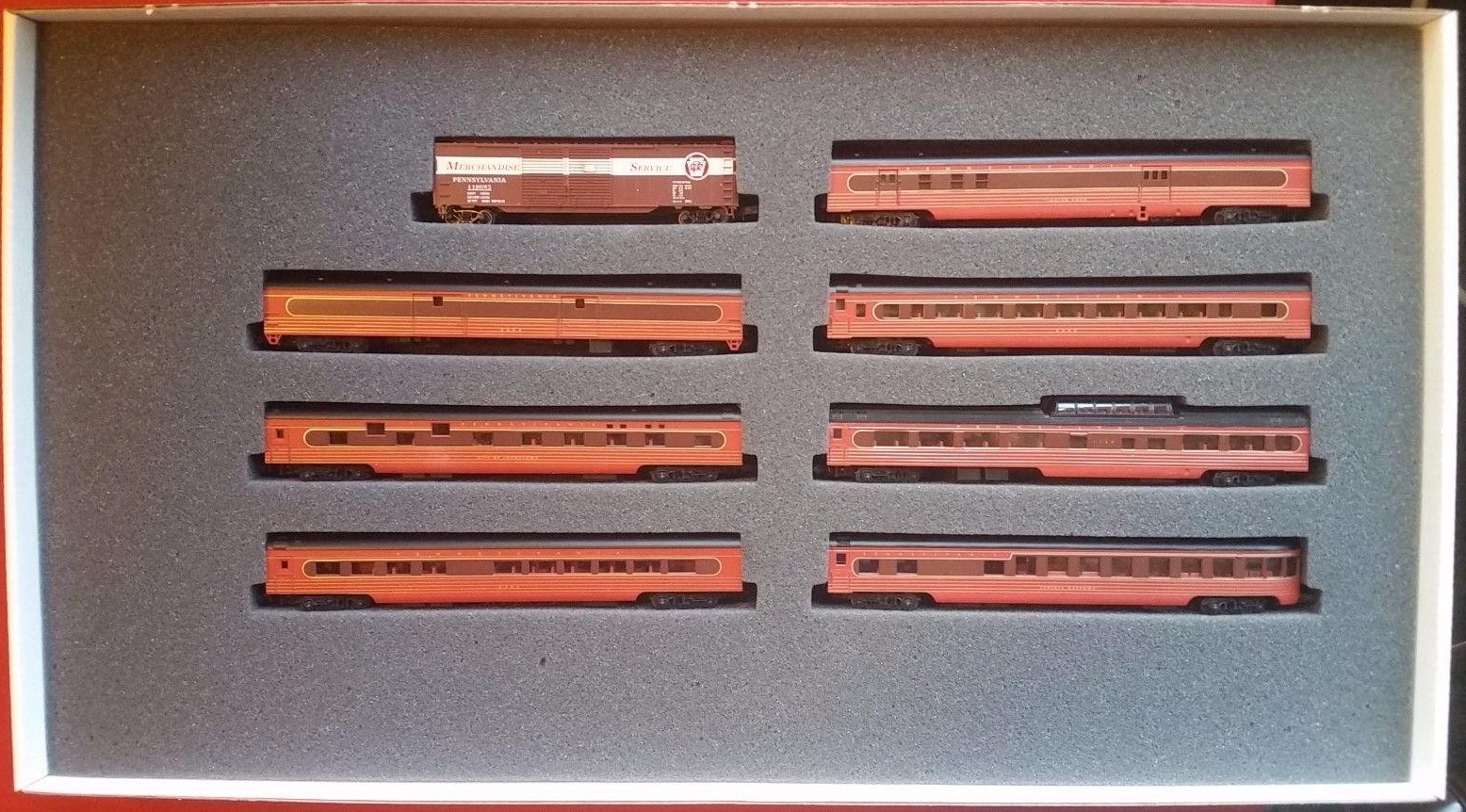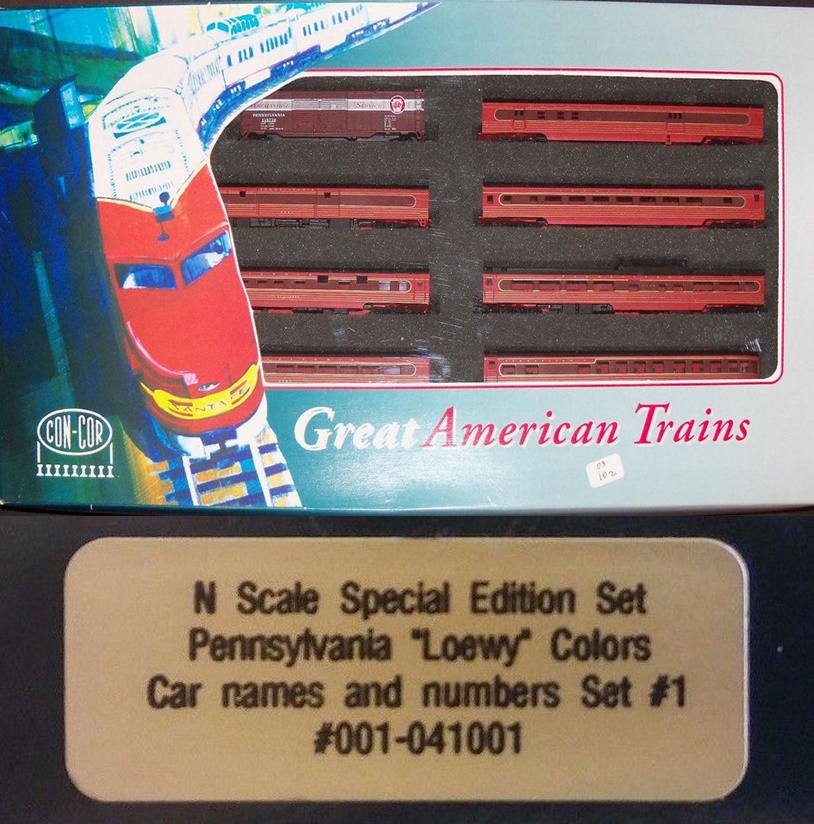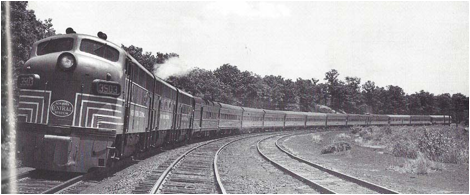Specific Item Information: Pennsylvania "Loewy" Colors "Special Edition Set" set #1: one boxcar and 7 streamlined cars.
- Merchandise Service 50' Box Car #118693
- RPO "Indian Rock"
- Baggage Car #8081
- Vista Dome Car #1120
- Sleeper Car "City of Johnstown"
- Coach #4008
- Diner #4501
- Observation car "Juanita Narrows"
Note: it is possible that some of the cars listed above may belong to the other "Loewy" set #2 and vice -versa.
- Merchandise Service 50' Box Car #118693
- RPO "Indian Rock"
- Baggage Car #8081
- Vista Dome Car #1120
- Sleeper Car "City of Johnstown"
- Coach #4008
- Diner #4501
- Observation car "Juanita Narrows"
Note: it is possible that some of the cars listed above may belong to the other "Loewy" set #2 and vice -versa.
Series Information: Con-Cor "Special Edition Sets" or "Special Limited Edition Sets" were the result of Con-Cor using the last of their stock of cars. Several new molds had to be made to accomplish this project as the original molds by Röwa had been destroyed in a fire. Several Röwa passenger cars in these sets were delivered unnumbered.
There has been two subseries:
First subseries - mid to end 1980s: These sets are furnished with usual wood-grained cardboard box that was used for the "Limited Edition sets'. The label does not have any mention of "Special" or "Limited" set. They contain locomotives and cars.
Second subseries - early 2000s: These sets were delivered in the colorful packaging 'Great American Trains' that was also used for the latest of the "Limited Edition Sets". They are marked " Special Edition Set" on the side label. They contain only cars; the matching locomotives were sold as separate items.
In this series, we have also listed sets that were delivered in the "Limited Edition Set" packaging, though not necessarily being 'Limited' in the sense that the locomotive and cars were generally available from open stock.
There has been two subseries:
First subseries - mid to end 1980s: These sets are furnished with usual wood-grained cardboard box that was used for the "Limited Edition sets'. The label does not have any mention of "Special" or "Limited" set. They contain locomotives and cars.
Second subseries - early 2000s: These sets were delivered in the colorful packaging 'Great American Trains' that was also used for the latest of the "Limited Edition Sets". They are marked " Special Edition Set" on the side label. They contain only cars; the matching locomotives were sold as separate items.
In this series, we have also listed sets that were delivered in the "Limited Edition Set" packaging, though not necessarily being 'Limited' in the sense that the locomotive and cars were generally available from open stock.
Prototype History: Passenger train consists during the transition era were a hedge-podge of different railcars. Many cars were pre-war heavyweights. Some of these heavyweights were rebuilt for postwar service while some were well worn vintage specimens. These were mixed in with newer streamlined cars in both smooth-side and corrugated varieties. Premier flagship trains of this period were usually all-lightweight consists with new colorful paint schemes trailing behind the latest and greatest diesel and/or steam motive power.
Road Name History: The Pennsylvania Railroad (reporting mark PRR) was an American Class I railroad, founded in 1846. Commonly referred to as the "Pennsy," the PRR was headquartered in Philadelphia, Pennsylvania.
The PRR was the largest railroad by traffic and revenue in the U.S. for the first half of the twentieth century. Over the years, it acquired, merged with or owned part of at least 800 other rail lines and companies. At the end of 1925, it operated 10,515 miles of rail line; in the 1920s, it carried nearly three times the traffic as other railroads of comparable length, such as the Union Pacific or Atchison, Topeka & Santa Fe railroads. Its only formidable rival was the New York Central (NYC), which carried around three-quarters of PRR's ton-miles.
At one time, the PRR was the largest publicly traded corporation in the world, with a budget larger than that of the U.S. government and a workforce of about 250,000 people. The corporation still holds the record for the longest continuous dividend history: it paid out annual dividends to shareholders for more than 100 years in a row.
In 1968, PRR merged with rival NYC to form the Penn Central Transportation Company, which filed for bankruptcy within two years. The viable parts were transferred in 1976 to Conrail, which was itself broken up in 1999, with 58 percent of the system going to the Norfolk Southern Railway (NS), including nearly all of the former PRR. Amtrak received the electrified segment east of Harrisburg.
The PRR was the largest railroad by traffic and revenue in the U.S. for the first half of the twentieth century. Over the years, it acquired, merged with or owned part of at least 800 other rail lines and companies. At the end of 1925, it operated 10,515 miles of rail line; in the 1920s, it carried nearly three times the traffic as other railroads of comparable length, such as the Union Pacific or Atchison, Topeka & Santa Fe railroads. Its only formidable rival was the New York Central (NYC), which carried around three-quarters of PRR's ton-miles.
At one time, the PRR was the largest publicly traded corporation in the world, with a budget larger than that of the U.S. government and a workforce of about 250,000 people. The corporation still holds the record for the longest continuous dividend history: it paid out annual dividends to shareholders for more than 100 years in a row.
In 1968, PRR merged with rival NYC to form the Penn Central Transportation Company, which filed for bankruptcy within two years. The viable parts were transferred in 1976 to Conrail, which was itself broken up in 1999, with 58 percent of the system going to the Norfolk Southern Railway (NS), including nearly all of the former PRR. Amtrak received the electrified segment east of Harrisburg.
Brand/Importer Information: Con-Cor has been in business since 1962. Many things have changed over time as originally they were a complete manufacturing operation in the USA and at one time had upwards of 45 employees. They not only designed the models,but they also built their own molds, did injection molding, painting, printing and packaging on their models.
Currently, most of their manufacturing has been moved overseas and now they import 90% of their products as totally finished goods, or in finished components. They only do some incidental manufacturing today within the USA.
Important Note: The Con-Cor product numbering can be very confusing. Please see here in the article how to properly enter Con-Cor stock numbers in the TroveStar database.
Currently, most of their manufacturing has been moved overseas and now they import 90% of their products as totally finished goods, or in finished components. They only do some incidental manufacturing today within the USA.
Important Note: The Con-Cor product numbering can be very confusing. Please see here in the article how to properly enter Con-Cor stock numbers in the TroveStar database.
Item created by: Alain LM on 2019-06-15 06:11:44. Last edited by Alain LM on 2020-05-31 05:24:53
If you see errors or missing data in this entry, please feel free to log in and edit it. Anyone with a Gmail account can log in instantly.
If you see errors or missing data in this entry, please feel free to log in and edit it. Anyone with a Gmail account can log in instantly.












